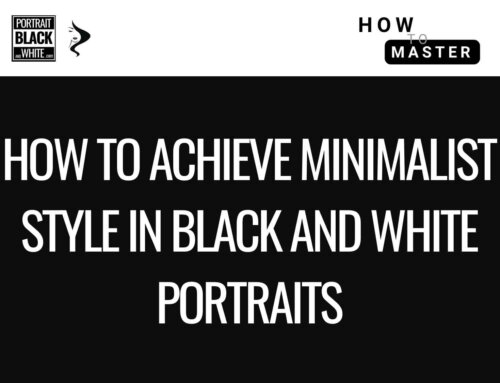The timeless appeal of black and white portraiture is tied closely to film. Photographers still reference the textures of Kodak Tri-X, Ilford HP5, or Fuji Neopan when describing the mood they want to achieve. Digital cameras deliver clean, flexible files, but that very cleanliness can feel sterile compared to the organic imperfections of film. Fortunately, with careful technique, digital portraits can carry much of the emotional weight and tactile quality of classic film without becoming artificial.
This guide explores how to emulate the film look in digital black and white portraits through capture choices, editing strategies, and subtle finishing.
What Defines the “Film Look”?
To recreate film faithfully, it is important to understand what made it distinct:
- Grain: Random silver halide crystals produced organic texture, not uniform noise. Grain varied in size and distribution depending on film speed and stock.
- Tonal response: Film curves were not linear. Shadows rolled off gently, midtones carried richness, and highlights compressed smoothly.
- Dynamic range: Most black and white films tolerated deep shadows and bright highlights with elegant falloff.
- Halation and bloom: Strong highlights sometimes glowed softly, adding atmosphere.
- Imperfect consistency: Every roll carried minor variations, giving images character and unpredictability.
Digital sensors interpret light differently—clinical, linear, predictable. The task is not to copy film mechanically, but to borrow its qualities that make portraits feel timeless.
Step 1 – Start with Capture That Leaves Room
A digital file that is too flat or too clipped will not respond well to film emulation.
- Expose for highlights: Just as with film, protect the brightest tones (forehead, cheekbones, catchlights). Overexposed highlights in digital break abruptly, unlike film’s gentle roll-off.
- Allow shadows to breathe: Avoid crushing blacks in-camera. Slight underexposure can be lifted later, mimicking film’s tolerance for shadow detail.
- Use lenses thoughtfully: Older glass with slight vignetting or lower contrast often produces a more filmic base than ultra-sharp, modern optics. Shooting wide open with vintage or manual-focus lenses can introduce natural softness.
The negative (digital RAW) is the foundation—give it latitude.
Step 2 – Choose a Film Stock as Reference
Not all films looked the same. Before editing, decide what mood you want to emulate:
- Kodak Tri-X 400: Gritty, punchy, classic street and portrait film. Distinctive grain with strong contrast.
- Ilford HP5 Plus: Balanced, versatile, forgiving. Smooth grain and wide tonal range—excellent for expressive portraits.
- Kodak T-Max 100/400: Clean and sharp with fine grain. More modern and clinical, yet elegant.
- Fuji Neopan: Crisp tones and slightly different grain structure—subtle but recognizable.
Studying the characteristics of film stocks helps direct editing choices rather than applying random “film look” filters.
Step 3 – Sculpt Tonal Curves
Film never responded to light in straight lines. To emulate this, curves must be adjusted deliberately.
- Soft highlight roll-off: Instead of pushing whites to maximum, create a gentle slope near the top of the curve. This keeps skin luminous without losing texture.
- Rich midtones: Deepen midtones slightly to mimic the density film produced, especially in skin and fabric.
- Open shadows with structure: Let shadows fall dark but avoid pure black except in controlled areas. A lifted shadow base feels more natural to the film aesthetic.
Each curve should feel organic—subtle “S” shapes are often more filmic than aggressive contrast moves.
Step 4 – Add Grain That Behaves Like Film
Digital noise is uniform and harsh, while film grain is random and organic. Simply increasing ISO does not replicate it. Instead:
- Apply grain in post-production, not in capture. Good grain simulation varies by size, softness, and distribution.
- Match grain scale to output. Large grain that looks beautiful on a 16×20 print may look distracting on Instagram.
- Avoid global, heavy application. Strong grain on faces can look like poor-quality digital noise. Instead, apply more grain in backgrounds and less on delicate skin.
The best simulations introduce slight irregularity, breaking digital perfection without overpowering detail.
Step 5 – Control Sharpness and Texture
Film rarely looked razor-sharp. Its beauty was in subtle softness combined with micro-contrast.
- Reduce digital over-sharpening. Lower default sharpening, then reintroduce crispness only in focal areas (eyes, hair edges).
- Use texture sliders sparingly on skin—film preserved texture naturally without exaggerated clarity.
- Consider adding a hint of lens blur or diffusion to highlights to mimic halation, especially in high-contrast setups.
The aim is to soften clinically sharp edges without making the portrait look unfocused.
Step 6 – Simulate Halation and Highlight Glow
One overlooked quality of film is the way highlights seemed to bloom slightly, especially when shot against strong light sources.
- A subtle glow can be added in editing by duplicating highlights, blurring slightly, and blending back at low opacity.
- Keep this effect minimal; it should be more felt than seen.
This soft blooming makes highlights appear less digital and more organic.
Step 7 – Accept Imperfection
Digital workflows encourage control and repeatability. Film never worked that way—dust, scratches, inconsistent development, or subtle variations were part of its charm.
To emulate film honestly:
- Allow small tonal quirks to remain—don’t perfect every gradient.
- Don’t smooth every blemish or line; film often amplified them.
- Consider introducing slight vignette or edge falloff to suggest natural lens behavior.
Perfection is the enemy of authenticity.
Step 8 – Test and Iterate
No two film simulations should look identical, just as no two rolls of film did. To refine your digital emulation:
- Create reference boards with scans of actual film portraits.
- Compare your digital edits side by side until the “feel” is similar.
- Save personal adjustment recipes, not universal presets.
Over time, this builds a personal interpretation of film rather than a generic filter.
Final Thought
Emulating film in digital black and white portraiture is less about copying and more about evoking. Grain, curves, softness, and imperfections all contribute, but what matters most is intention. Digital allows precision—film celebrated unpredictability. When those two meet thoughtfully, the result is portraits that combine the flexibility of today with the timeless soul of yesterday.
A digital file can never truly be film, but it can carry its spirit: portraits that feel textured, human, and enduring.




Scrivi un commento